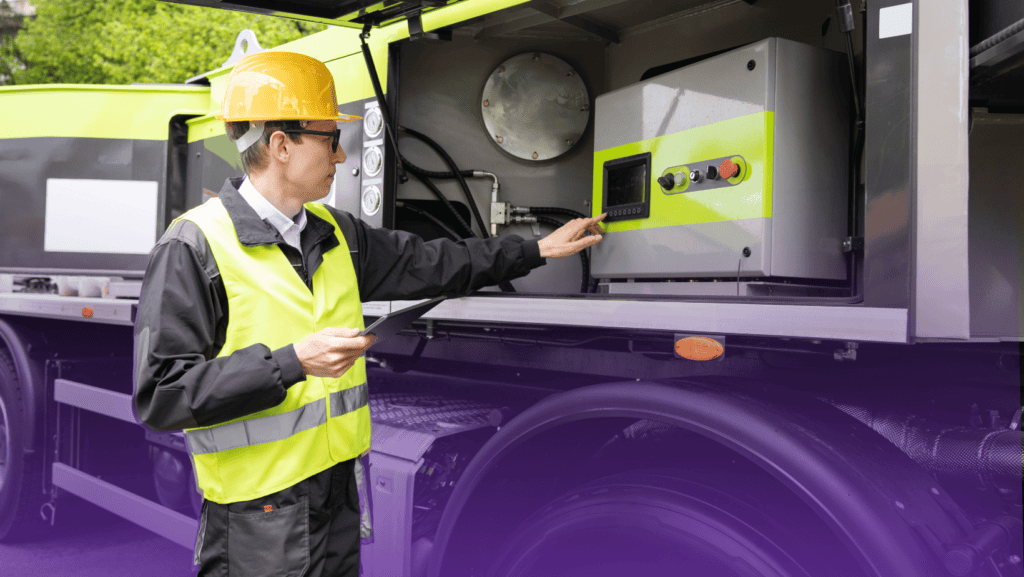As we kick off 2025, it’s time to prioritize fleet safety and set clear goals for a safer, more efficient year. Whether you manage a handful of vehicles or a large-scale fleet, these 10 tips will help you reduce risks, keep your drivers safe, and ensure smooth operations. Let’s explore the strategies that will keep your fleet at its best this year!
Workplace Fleet Safety Tips For 2025
1. Start with a Safety Reset
New year, new goals! The beginning of 2025 is the perfect time to reset your fleet safety practices. Review your fleet management program and safety procedures to ensure they align with current standards. Consider hosting safety meetings, providing refresher training, or updating policies to address emerging concerns. Keeping safety front and center fosters a culture of accountability where everyone plays a part in preventing accidents.

2. Leverage Technology for Near Real-Time Insights
Fleet safety technology is a game-changer. Tools like MVR Monitoring or GPS tracking systems provide near real-time insights into driver behavior, vehicle performance, and potential risks. These technologies enhance safety and improve operational efficiency by offering data-driven visibility into your fleet’s performance.
3. Set Clear Expectations with a Safety Policy
An up-to-date safety policy is the backbone of a successful fleet safety program. Your 2025 policy should clearly outline expectations for drivers, covering seatbelt use, vehicle inspections, distracted driving, and fatigue management. Regularly review and update these policies to address new challenges, ensuring everyone understands what’s expected both on and off the road.
4. Invest in Ongoing Driver Training
Safety training shouldn’t be a one-time event. Regularly offer education on defensive driving, emergency procedures, and other relevant topics. Ongoing training ensures your drivers are always prepared for the unexpected, reducing the risk of accidents and keeping your fleet safe.
5. Conduct Routine Vehicle Inspections
To enhance workplace safety, ensure your vehicles are road-ready with regular maintenance and inspections. Routine checks—like tire pressure, brakes, lights, and oil levels—help prevent breakdowns and costly repairs. Plus, the Federal Motor Carrier Safety Administration (FMCSA requires annual inspections for Commercial Motor Vehicles (CMV), ensuring compliance and road safety.

6. Monitor and Manage MVRs Regularly
Stay ahead of potential issues by regularly monitoring your drivers’ Motor Vehicle Records (MVRs). This proactive approach helps you catch suspended licenses or recent violations before they escalate.
89% of fleets that have implanted MVR Monitoring have significantly enhanced their ability to identify and address behaviors, with over half reporting significant improvements. Source: 2024 Customer Survey
7. Reward Safe Driving with an Incentive Program
Encourage safe driving by recognizing and rewarding it. Whether through a points system, monetary rewards, or public recognition, a safety incentive program motivates drivers to maintain good habits. The result? Fewer accidents, reduced liability, and a more engaged team.
8. Enhance Accountability with Dash Cams
Dash cams and telematics are invaluable tools for fleet safety. Not only do they capture real-time footage of driving behaviors, but they can also help resolve disputes, enhance driver training, and provide data to improve overall fleet safety.
9. Stay Ahead of Regulatory Changes
Transportation regulations evolve regularly. From driver qualifications to hours-of-service rules, staying informed ensures compliance and avoids legal risks. Subscribe to industry updates, attend safety seminars, or use tools that notify you about regulatory changes to keep your fleet in check.
10. Communicate and Collaborate Regularly
Open, consistent communication is essential to maintaining safety. Hold regular safety check-ins, share pre-trip reports, and establish clear emergency communication plans. Transparency about incidents or near-misses fosters a learning environment where everyone works together to prevent future issues.
Let’s Make This Year the Safest Yet!
By following these 10 tips, you can look forward to a year of safer driving, fewer accidents, and a more efficient fleet. Remember, safety doesn’t happen by accident—it’s the result of proactive planning, ongoing training, and a team-wide commitment.
Ready to elevate your fleet safety? Explore our solutions, MVRs, and MVR Monitoring, or watch the video.






